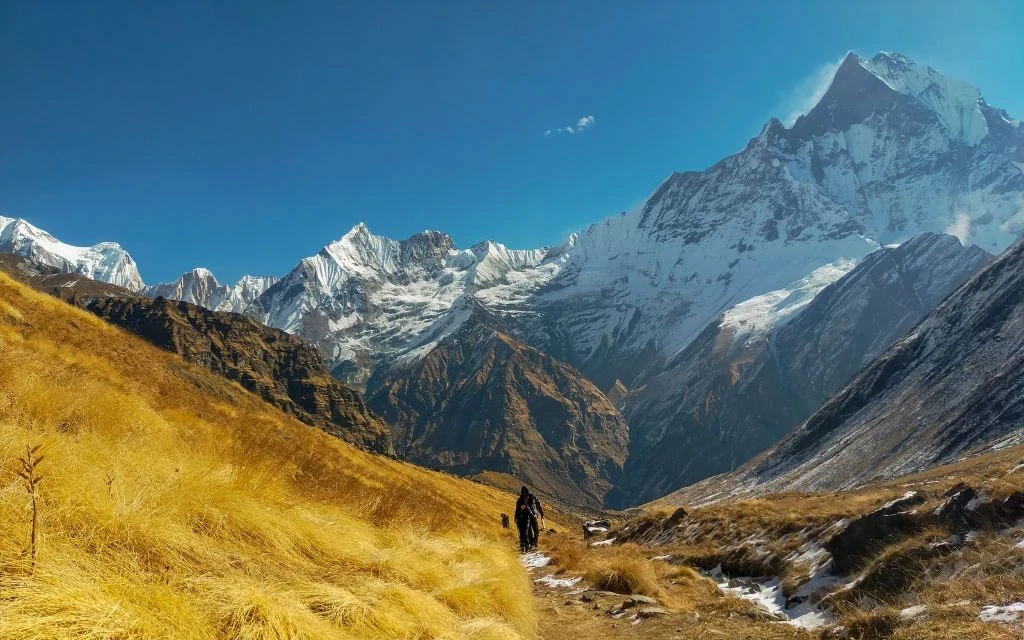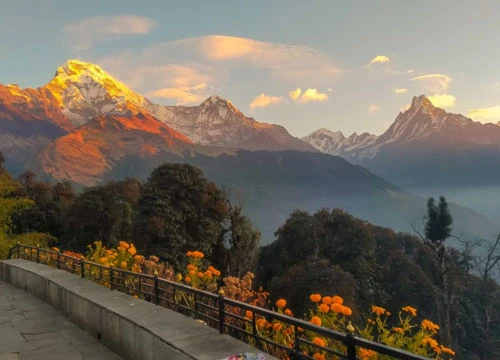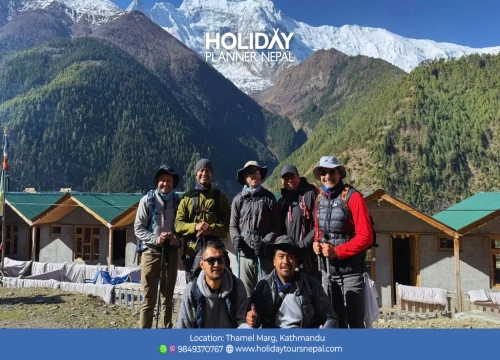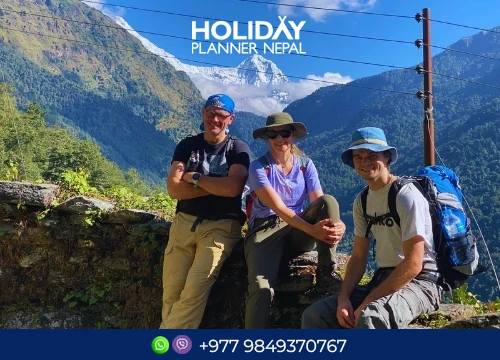Introduction: Annapurna Base Camp Short Trek 2025/2026
Annapurna Base Camp short trek is one of the most exciting trekking packages offered by holiday planner Nepal. Annapurna Base camp (4,130meters/ 13,550 feet) trek summarizes mesmerizing views of gigantic mountain ranges, lushly green rhododendrons, bamboo and alpine forests, spectacular landscapes, and culturally rich Gurung and Magar villages. Thus, this trek is recommended for nature lovers.
Travelers can reach two major base camps during this trek. Machapuchare base camp (3700 meters/ 12,139 feet) and Annapurna Base Camp (4,130m/ 13,550 feet). Machhapuchre Base Camp (MBC) is one of the two that offers splendid views of the Annapurna range and somehow the trek would feel incomplete without reaching this point. The views of the snow-capped peaks, the Machapuchare Valley, the mountain towns, and the verdant hills are the main attractions of ABC Trek. This means if you want to immerse yourself in Nepal's natural environment and cultural way of life. Then definitely this trek is the right choice.
Likewise, Annapurna Base Camp (ABC) is the main destination of this trek. Annapurna Base Camp (4,130m/ 13,550 feet) lies inside the Annapurna Conservation Area which is about 40 km/24.85 miles from Pokhara. ABC offers mesmerizing views of Fishtail, Hiunchuli, Dhaulagiri, Tilicho, Pisang, Paungda Danda, and the infamous Annapurna Massif.

Highlights for Annapurna base camp trek
Enjoy the panoramic views of Annapurna I, Annapurna III, Annapurna South, Gangapurna, Hiunchuli, Singu chuli, Tharpu chuli, Gandharba chuli, Baraha Shikhar and Machapuchare from the base camp.
- Annapurna Base Camp trek is a short trip. However, get yourself ready to witness Annapuna Massif from the base camp.
- Witness the best sunrise and sunset in Nepal, with authentic cultures and lifestyles.
- Be at the base of Machapuchare(Fish Tail) mountain (3700m/12140 feet).
- 360-degree amazing view of mountains which feels like standing in the stadium of mountains.
- Visit to culturally rich Ghandruk village at the trail.
- First-hand experience of the largest rhododendron forests, the river valleys, the various terrains, and the mixed topography all contribute to the area's rich vegetation.
- 8 Days inclusive package trek to Annapurna Base Camp.
Some key points about Annapurna base camp short trek
- Maximum altitude: Annapurna base camp at 4130meters (13,549 ft)
- Starting altitude: Ghandruk at 1930meters (6332ft)
- Total trek distance: 70-75 kilometers (43046miles)
- Daily average distance: 10-15kilometers (6-9miles)
- Trek starting point: Ghandruk, Pokhara, Nepal
- Trek ending point: Jhinu village, Pokhara, Nepal
- Difficulty level: walk that includes climbing and descending through hills
- Trek grade: Moderate
- Types of tea house: Basic with basic facilities
- Communication: Network is available but not stable throughout the trek
How does the Annapurna base camp trek start and end?
Annapurna Base Camp 8 days trek with Holiday Planner Nepal offers a short package compared to most of the trek leading to Annapurna region. The trip begins from Kathmandu to Pokhara either by road or air. After the well-spent day in Pokhara, the day begins with a drive towards Ghandruk from lakeside Pokhara in about 4-5 hours’ drive. Ghandruk is a Gurung village in the northwest part of Pokhara which offers panoramic views of Annapurna Massif: the 10th highest mountain. The hospitality and cultural programs in Ghandruk provide a spectacular insight into the Gurung culture of Nepal.
Trekking begins once we reach Ghandruk. The next destination is Chomrong which takes about 6-7 hours to hike from Ghandruk. Chomrong village (2170m/7,119 feet) has a population of 500-600 individuals. This place is one of the key destination points for hikers during theABC trek. Chemrong is native to the Gurung community where most of them are professional British army soldiers. The best way to spend time in Chomrong is by resting in hotels and restaurants after a hectic hike. This place is famous for its mountainous view and hot drinks which can be available early morning.
After spending the night at Chomrong, the next destination is Dovan 2630 m. This takes about 6 hours hike. Travelers are placed in Teahouses of Dovan where they spend time resting and energizing themselves to prepare for the next day's hike to Machapuchare base camp.To reach Machapuchare base camp, trekkers hike down from Dovan. The time of hiking is around 6 hours depending upon the speed. The night is spent in teahouses located at the base camp.
The next day, travelers move from Macchapuchre base camp (MBC) to Annapurna base camp (ABC) with gradual up-and-down trails. After a hike of 3 hours, we reach 4130m which is the base of Annapurna. This is the highest point in our trekking and after reaching the point trekkers gradually ascend back to bamboo located at 2345m. This takes about a 6-hour hike from Annapurna Base Camp. The night is then spent at a teahouse located in Bamboo.
The second last day of the tour includes the trip from Bamboo to Jhinu village. This village is a means of refreshment and rejuvenation for travelers as this place consists of natural hot springs. The cost for springtime is cheap $0.99 hence is one of the major attractions for tourists.At the end of the journey, visitors collect souvenirs and head down the road to return to Pokhara which is about 5 hours depending on the traffic.
Annapurna Base Camp Short Trek Itinerary
Day | Activity | Altitude (m/ft) | Distance (km/miles) | Duration (hours) | Elevation Gain/Loss |
01 | Drive to Ghandruk Village | 1,930 m / 6,332 ft | ~10 km / 6.2 miles (drive) | ~5 hrs (drive) | +1,930 m / +6,332 ft |
02 | Trek to Chomrong | 2,170 m / 7,119 ft | ~10 km / 6.2 miles | ~6 hrs (trek) | +240 m / +789 ft |
03 | Trek to Dovan | 2,630 m / 8,628 ft | ~12 km / 7.5 miles | ~6 hrs (trek) | +460 m / +1,509 ft |
04 | Trek to Machapuchare Base Camp | 3,700 m / 12,139 ft | ~10 km / 6.2 miles | ~6 hrs (trek) | +1,070 m / +3,507 ft |
05 | Trek to Annapurna Base Camp | 4,130 m / 13,549 ft | ~5 km / 3.1 miles | ~3 hrs (trek) | +430 m / +1,411 ft |
06 | Trek from Annapurna Base Camp to Bamboo | 2,345 m / 7,693 ft | ~12 km / 7.5 miles | ~6 hrs (trek) | -1,785 m / -5,858 ft |
07 | Trek to Jhinu Village with Hot Springs | 1,780 m / 5,839 ft | ~12 km / 7.5 miles | ~6 hrs (trek) | -565 m / -1,846 ft |
08 | Trek to the road head and drive to Pokhara | 860 m / 2,822 ft | ~10 km / 6.2 miles (trek), ~25 km / 15.5 miles (drive) | ~5 hrs (trek), ~1 hr (drive) | -920 m / -3,018 ft |
Optional activities to do in Pokhara before or after Annapurna Base Camp short trek?
Visitors can begin with sightseeing around Pokhara, the city of lakes. This is accompanied by a night walk around the famous Phewa Lake with activities including boating and sightseeing around the lake. Other possible locations in Pokhara can be Shree Bindhyabasini Temple, International Mountain Museum, Tal Barahi Temple, Sarangkot, Devi’s Falls, Gupteshwor Mahadev Cave, Gurkha Memorial Museum, Mahendra Cave, Chamere Gufa, World Peace Pagoda, Begnas Lake and Pumdikot.
While these can be some major attractions for tourists’ other activities around the area can be boating at Phewa lake or Vegnas taal, sunset or sunrise at Sarangkot, meditation, yoga, bungee jumping, paragliding, rafting, clubbing, live music bar, hot air balloons, and many more.
What is the best season or time for Annapurna base camp short trek?
The trekking season for Annapurna Base Camp in Nepal is normally done in Spring, Autumn, Winter, and Monsoon. The best season to embark on Annapurna Base Camp is Spring and Autumn while Winter and Monsoon is less preferred.
Spring from March to May is the best time to travel towards the Annapurna region. The weather is mild with temperatures ranging from -8 to 14 degrees Celsius. The weather is mostly pleasant with bright skies and favorable temperatures. The trails are filled with rhododendron woodland which presents a breathtaking display of crimson color all around the forest. The trails are dry with cool breezes and aromas along the way.
Autumn is another best season for an 8-day Annapurna Base Camp Trek. Autumn in Nepal lasts from mid-September to the end of November. The weather in this period is cool and dry with clear visible skies. Thus Autumn offers striking views of majestic peaks like Mt Annapurna I(8,091 m/ 26,545 ft),Annapurna III (7,555 m/ 24,787 ft), Annapurna South(7,219 m/ 23,684 ft), Gangapurna(7,455 m/ 24,459 ft), Gandharva Chuli(6,248 m/ 20,499 ft), Himalchuli(6,816 m/ 22,362 ft), Macchapucchre(6,993 m/ 22,943 ft).
Despite these seasons winter and monsoons can also be possible choices for adrenaline enthusiasts. However, winter and monsoon are not the recommended times for Annapurna Base Camp Trek. There may be fewer individuals who prefer this time due to its difficulty. The Annapurna Base Camp map will be difficult as there will be fewer availability of teahouses. The trails become slippery and visibility is poor due to clouds. The frequent rain and storms can cause high altitude elevation a problem. Holiday Tours Nepal can help to trek in Annapurna base camp however it is not recommended.
How difficult is Annapurna base camp short trek?
Everyone may appreciate and enjoy strolling through nature while on this walk because it is quite easy to complete and doesn't demand highly developed physical fitness levels. A traveler with prior hiking experience and a healthy body can do it swiftly. We will ascend to an elevation of 4130 meters above sea level. Necessary preparations are made by the Holiday planner team and any additional requirements if needed can be made possible on a prior notice. However, necessary precautions must be taken by an individual in any case of emergency.

For whom is Annapurna base camp short trek?
You should carefully consider your interests and abilities before deciding if the Annapurna Base Camp (ABC) trip is the perfect adventure for you. It requires careful consideration of your interests and skills to determine whether the Annapurna Base Camp (ABC) trip is the ideal adventure for you. This well-known journey in Nepal offers a chance to fully immerse yourself in the breathtaking splendor of the Himalayas, where you'll see stunning mountain panoramas, deep forests, and vibrant Nepali culture. Since the voyage entails daily trekking across varied terrain, including steep climbs and valleys, your physical health is a key consideration.
Although it helps to have some prior hiking experience, a modest degree of fitness is sufficient. Since the walk can reach heights of up to 4,130 meters (13,550 feet) at Annapurna Base Camp, altitude acclimatization is especially crucial. Altitude-related dangers must be recognized and managed. Choose the right season for the finest weather conditions by taking into account the time commitment, which normally ranges from 7 to 12 days.
In addition, the ABC trek can be a profoundly satisfying experience if you enjoy physical challenges and cultural exploration. It will provide you with cultural insights and a sense of accomplishment in the heart of the Annapurna region. Make sure you are prepared and willing to follow Nepal's rules and laws before starting your tour. For those who value the natural beauty of the Himalayas, the ABC trip has an opportunity to be an insightful and revolutionary experience.
Food and tea houses during Annapurna base camp short trek
The more popular international cuisines (Tibetan, Continental, Italian, Indian, etc.) as well as authentic Nepalese food are available to us throughout the Annapurna Base Camp Trekking route. Lunch will be served en route to the next site, while breakfast and dinner will be offered in the teahouses or off the menu of the lodge where we spend the night. Additionally, there will be welcome and goodbye dinners for visitors on the day of arrival and before the day of departure. Here is an overview to get an idea about the lunch, breakfast, and dinner options.
- Breakfast: Omelets, bread, pancakes, chapatis and mixed vegetables, porridge, pasta, macaroni, oatmeal and cereals, Varieties of soup.
- Lunch and Dinner: Dal Bhat, Lasagna, Chicken, Potato dish, Pizza, Noodles, MO: MO, Spring rolls, and other varieties of dishes.
Visitors also can have drinks and beverages like Coffee, Tea, Rum, Vodka, Wine, and a wide option of beers to choose from. However, Holiday Tours Nepal recommends fellow travelers omit alcoholic drinks during the trek as this can cause serious problems during the trek.

For accommodation, the ABC region of Nepal offers a variety of hotels. You can choose to stay in several lodges, teahouses, and guesthouses while on your tour. Even though these lodgings are sometimes basic, they offer a pleasant location to relax and recover after a day of hiking. A brief description of accommodation varieties in the Annapurna region provided by Holiday Tours Nepal is given below:
- Teahouse and Lodges: There are many teahouses and lodges options all along the route in this short trek to Annapurna Base Camp. Teahouses are small guesthouses that offer basic rooms with beds and blankets. However, the bathroom facility might be compromised as they need to be shared.
- Camping: Camping is a suitable and recreational activity in this region. Campers can sleep in the wonders of Nature with fresh air and wildlife which helps in stress reduction with an opportunity to connect with Nature. However, camping requires more logistic preparation which can be handled by Holiday Tours Nepal.
- Guesthouse and Homestay: Guest houses and Homestay can be another accommodation option during this Annapurna short trek. They are the accommodations where visitors can stay with local families in their homes at a fair price. They can also try local cuisines and get insight into the local culture.
- Luxury houses: They are a more expensive and premium option for trekkers who want to spend quality and hassle-free services. These provide quality and cozy amenities like comfortable rooms, electric blankets, attached bathroom facilities, hot showers, and a heating system.
How to prepare for Annapurna base camp short trek?
The basic thing to do is get your body physically ready for this adventurous trip. It will be hard to travel such a distance on foot. Failure to do so will greatly reduce the journey experience and it will be difficult to accept failure once you embark on your journey. So physical exercises before the tour are recommended. Avoid travelling by vehicle and getting used to walking is recommended. Any sort of cardiovascular exercise will aid during the hike.
Another factor can be luggage weight. Follow light packing yet sufficient for at least 8 days. Trekkers won’t be able to enjoy trips across Himalayan ranges if packing is not done wisely. This trip follows lodge to lodge trek sleeping. Hence proper gear and equipment will make trekkers ready for any changing scenarios mainly if travelling is done in the winter season.
NOTE: that any information regarding the packing list for the Annapurna Base Camp trek is provided by Holiday Planner Nepal.
Permits cost for Annapurna Base Camp Trek
Nationality | Annapurna Conservation Area | Tims Card | Apply for permits now |
Indian citizens | Rs 1500 | Rs 1000 | Apply for permits |
Foreign citizens | Rs 3000 | Rs 2000 | Apply for permits |
Nepali citizens | Rs 100 | Rs 100 | Apply for permits |
Note: Children’s below 8 years don’t require permits.
Where to get the permits for Annapurna base camp?
Annapurna conservation area permit can be obtained at Kathmandu and Pokhara. Tims card is issued by a registered trekking agency of Nepal whose tax must be cleared till the latest fiscal year.
Note – Annapurna conservation area permit works for both Annapurna circuit trek and Annapurna base camp trek.
Where can independent trekkers get TIMS card?
Independent trekkers can get your TIMS card (who are trekking solo) can reach out to the Tourist Service Centre located in Kathmandu. The office is 15-minute away from Thamel, and is located at Pradarshani Marg (Street).
Trekkers going solo, can visit the Tourist Service Centre as you should be able to purchase not only your TIMS card but also all other necessary trekking permits.
Is travel insurance required for Annapurna short trek?
Travel insurance is not necessary, particularly for the Annapurna Base Camp trek. However, having travel insurance will assure fellow travelers of any uncanny circumstances. It can protect in the event of unanticipated events, such as trip cancellation, medical issues, lost or stolen property, etc. Travel insurance can assist you in recovering some or all of your costs if you have to cancel your trip or if something goes wrong while you are on the road.
Although theft is rare, it does happen, so make sure all valuables are hidden. Travelers can leave any valuables in our office locker while traveling. Please follow your guide's instructions if there is a landslide, avalanche, flooding, or earthquake on the mountain. Likewise, if you become ill, let your guide know right away.
Can trekkers get altitude sickness during Annapurna base camp short trek?
Since the trek entails a major ascent in altitude, the danger of Acute Mountain Sickness (AMS) during the Annapurna Base Camp (ABC) trek in Nepal is only marginally minor. Rapid ascent to higher elevations without enough acclimatization is a common cause of AMS. Annapurna Base Camp, which is located at roughly 4,130 meters (13,550 feet) above sea level, is the highest point on the ABC journey.
To minimize the chances of AMS, trekkers are advised to follow certain precautions
- Proper Acclimatization
- Stay Hydrated
- Listen to Your Body
- Go slowly
- Consult the professionals
Local culture and tradition seen during Annapurna base camp trekking
This trek takes travelers through several traditional Gurung and Magar villages. Such a village can be explored in Ghandruk and Chomrong. These villages have distinct culture and traditions which enables visitors to interact with the locals and learn their way of life.
Similarly, another point of attraction is the local cuisine. Nepal’s diverse food culture can be experienced during this trek. Visitors savored traditional dishes like dal Bhat (lentil soup with rice), Mo:Mo(dumplings), and various types of veggies. As we move towards a higher elevation into the Annapurna region, a glimpse of Buddhist monasteries and stupas can be seen. If lucky travelers might get a chance to participate in prayer sessions and receive blessings from a monk.
What are the permits and documents required for Annapurna base camp short trek?
Traveling towards Annapurna Conservation Area is fun. Apart from that some logistics need to be handled. Various permits and documents are required for both national and international visitors which are listed below:
- TIMS (Trekkers Information Management System):A TIMS card is also required for trekkers, as it aids in tracking and provides emergency assistance. TIMS cards come in two varieties: one for planned journeys and another for solo hikers. Holiday Tours Nepal, a prestigious trekking agency in Kathmandu, can help travelers get TIMS cards from Nepal Tourism Board. A TIMS card is necessary for international individuals who are planning to embark on Annapurna Short Trek route.
- Annapurna Conservation Area Permit (ACAP): Since the Annapurna Conservation Region is protected. Therefore, to enter such a protected region, hikers must get a permit known as an ACAP permit. The Holiday Tours Nepal trekking agency in Kathmandu can help to get this permit. This permit can be prepared at Pokhara which is before the start of the hiking route.
Other documents that are required: A valid Passport and Visa, Travel Insurance, Trekking permits for Support Staff, and any Emergency Contacts.



 General
General Upper Body
Upper Body Torso
Torso Lower Body
Lower Body Hands
Hands Feet
Feet Undergarments and Inner Wears
Undergarments and Inner Wears First Aid Kits and Medications
First Aid Kits and Medications Other Essentials
Other Essentials




